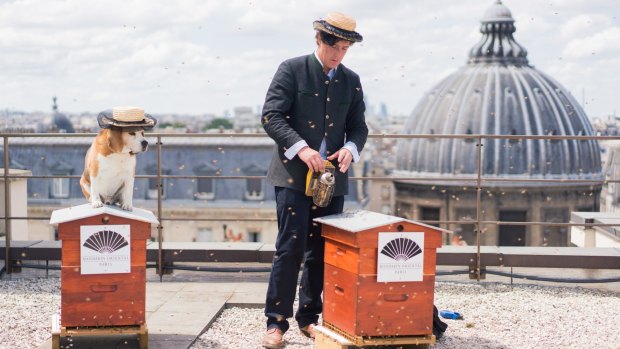This was published 2 years ago
Beehives on hotel rooftops are helping create new bee habitats
By Lee Tulloch

Honey production on the rooftop of the Mandarin Oriental, Paris.
At Southern Ocean Lodge on Kangaroo Island the honey from the island's sanctuary of disease-free Ligurian bees was so plentiful, the lodge's spa featured a treatment where guests were dipped in warm honey and then wrapped in a sheet to allow the skin to absorb the beneficial properties of the nectar. It was soothing and sensual and also very sticky.
Those sweet days seem so indulgent now. The apocalyptic bushfires of January 2020 not only turned the lodge to cinder, it annihilated thousands of native animals and their habitat and destroyed about 1000 beehives and the tens of thousands of bees inside, about a quarter of the island's bee population. Luckily the breed survived, but beekeepers think it might take 15 years to recover the same level of honey production.
The catastrophic wildfires in Greece this month have similarly destroyed hives, bees and honey processing plants. The world's honeybee populations were already in serious decline before the acceleration of the climate emergency, due to the widespread use of pesticides. Bees are particularly susceptible to the devastation caused by fire and drought to the trees, flowers and vegetation that provides pollen for their honey. When bees aren't pollinating plants, we have a food supply crisis. About 90 per cent of the world's plants and 30 per cent of the crops rely on bees for cross-pollination.
To help maintain bee populations, beekeeping has become a business in urban as well as rural areas - anywhere there's a rooftop or sheltered terrace, in fact. In the last couple of decades hotels have joined the mission to provide more bee habitat by donating vacant outdoor space to beehives. The Fairmont Waterfront in Vancouver claims to be the first, introducing its hives in 2008.
Since then, hundreds of urban hotels worldwide have begun producing their own honey, from the Waldorf Astoria on Manhattan and the Mandarin Oriental in Paris to the Chesterfield in Mayfair, where bees make honey from blooms in nearby Buckingham Palace and St James Park.
In Australia, bees are busy on the rooftops of the Burleigh Pavilion on the Gold Coast, the Rendezvous in Perth and the Mayfair in Adelaide. In Melbourne, the Alto Hotel and the Sebel Flinders Lane have worked with Rooftop Honey, a group of apiarists that also provides hives for the Emporium shopping precinct in the city.
In Sydney, Doug Purdie and Vicky Brown of The Urban Beehive are maintaining hives on David Jones, Hermes, Swissotel and the Shangri La, as well as in the Botanic Gardens. For hotels, beekeeping is a point of difference, Purdie says. There's a curiosity value in the dripping honeycomb frame on the breakfast buffet and the spoonful of rooftop honey shaken into a cocktail, although a few beehives aren't going to produce all the honey a big hotel might need.
Doug Purdie supplies urban rooftops with European honeybees, which are the only species that can provide honey in quantity. "The native bees don't make huge amounts of honey but they are very, very important for pollination."
"Bees zoom all over the place," he says. They can travel up to 10 kilometres looking for pollen. "Amazingly the city has quite a number of nectar resources. You've got the obvious one, the Botanic Gardens, but there are other street plantings and other locations in the city that the bees go to get nectar. There's quite a lot of food for them in the city."
The honey can also be surprisingly delicious. "It depends upon what the bees happen to be foraging on but urban honey tends to be very complex" because of the different plant sources. And if anyone is worried about pollution, bees have a mechanism that completely removes pollution from nectar. "The takeout is the honey is clean."
Not every hotel or location is ideal for bees, Purdie says. "They need good access because honey is really heavy, and they need enough protection from the elements, so if it's a really hot or windy location it's no good for putting bees." At the Shangri-La, a high-rise hotel, they chose a sheltered podium on a lower level.
Of all the insects, entomologists consider honeybees the smartest. They're capable of learning and solving problems. Scientists estimate they can count up to four. Social animals, they communicate with nest mates and travel in figure-eight patterns which alert other bees to the distance to a food source. They can recognise and distinguish between human faces.
Bees are tiny and their loss can be invisible, not as visually dramatic as walls of fire or ice shelf collapse. World Honey Bee Day is held on August 21 each year to celebrate these busy geniuses of the insect world, throw a light on their vital importance, and make sure they remain buzzworthy.
Sign up for the Traveller newsletter
The latest travel news, tips and inspiration delivered to your inbox. Sign up now.